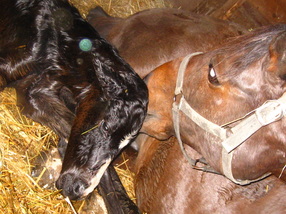Imprinting and Attachment

Imprinting is a natural process in many animals with extended parental care, including birds and mammals. In the animal behavior and human psychology literatures, imprinting and attachment refer to the social connection that develops between a young animal and its caregiver. Because foals are up and moving around almost immediately, mares learn (imprint on) the scent of their foals right after birth and foals likewise learn to recognize (imprint on) their mothers.
Attachment refers to the bond between a young animal--the foal--and its caregiver--the mare. The mare's behavior and the foal's temperament contribute to the quality of the attachment between them. In humans, secure attachment predicts later psychological well-being and good social skills, whereas insecure attachment predicts psychological and social problems. A promising area of research in equine behavior is to evaluate the different styles and quality of mare-foal attachment, and in a longitudinal study follow its effect on the adolescent and adult horse.
In the popular equine literature the term imprinting has been commandeered to refer to a training method (i.e., imprint training) developed by Robert Miller, DVM, that is used to build a connection between the newborn foal and its human caregiver. It is more correctly known as neonatal handling. Although regular handling of young foals is important, no long-term advantages of prolonged manual stimulation of the foal immediately after birth have been found. In fact, this training technique may create unnecessary stress on the foal, delay suckling, which provides foals with immunodefense compounds from colosturm, and interfere with the attachment bond between mare and foal, which has potential negative consequences on the foal's social development. Extensive handling and grooming of the mare in a relaxed manner is a more effective way to socialize foals to humans and improve later handling and training success.
Selected References:
Henry, SS, et al. (2009) Neonatal handling affects durably bonding and social development. PloS one 4, e5216
Lansade, L, et al. (2005) Effects of neonatal handling on subsequent manageability, reactivity and learning ability of foals. Applied Animal Behaviour Science 92, 143-158.
Simpson, BS. (2002) Neonatal foal handling. Applied Animal Behaviour Science 78, 303-317.
Spier, S, et al. (1997) Outcome of tactile conditioning of neonates, or "imprint training" on selected handling measures in foals. Veterinary Journal 168 (3), 252-258.
Williams, JL, et al. (2003) Effects of imprint training procedures at birth on the reactions of foals at age six months. Equine Veterinary Journal 35 (2), 127-132.
Attachment refers to the bond between a young animal--the foal--and its caregiver--the mare. The mare's behavior and the foal's temperament contribute to the quality of the attachment between them. In humans, secure attachment predicts later psychological well-being and good social skills, whereas insecure attachment predicts psychological and social problems. A promising area of research in equine behavior is to evaluate the different styles and quality of mare-foal attachment, and in a longitudinal study follow its effect on the adolescent and adult horse.
In the popular equine literature the term imprinting has been commandeered to refer to a training method (i.e., imprint training) developed by Robert Miller, DVM, that is used to build a connection between the newborn foal and its human caregiver. It is more correctly known as neonatal handling. Although regular handling of young foals is important, no long-term advantages of prolonged manual stimulation of the foal immediately after birth have been found. In fact, this training technique may create unnecessary stress on the foal, delay suckling, which provides foals with immunodefense compounds from colosturm, and interfere with the attachment bond between mare and foal, which has potential negative consequences on the foal's social development. Extensive handling and grooming of the mare in a relaxed manner is a more effective way to socialize foals to humans and improve later handling and training success.
Selected References:
Henry, SS, et al. (2009) Neonatal handling affects durably bonding and social development. PloS one 4, e5216
Lansade, L, et al. (2005) Effects of neonatal handling on subsequent manageability, reactivity and learning ability of foals. Applied Animal Behaviour Science 92, 143-158.
Simpson, BS. (2002) Neonatal foal handling. Applied Animal Behaviour Science 78, 303-317.
Spier, S, et al. (1997) Outcome of tactile conditioning of neonates, or "imprint training" on selected handling measures in foals. Veterinary Journal 168 (3), 252-258.
Williams, JL, et al. (2003) Effects of imprint training procedures at birth on the reactions of foals at age six months. Equine Veterinary Journal 35 (2), 127-132.
© 2012 Robin Foster
